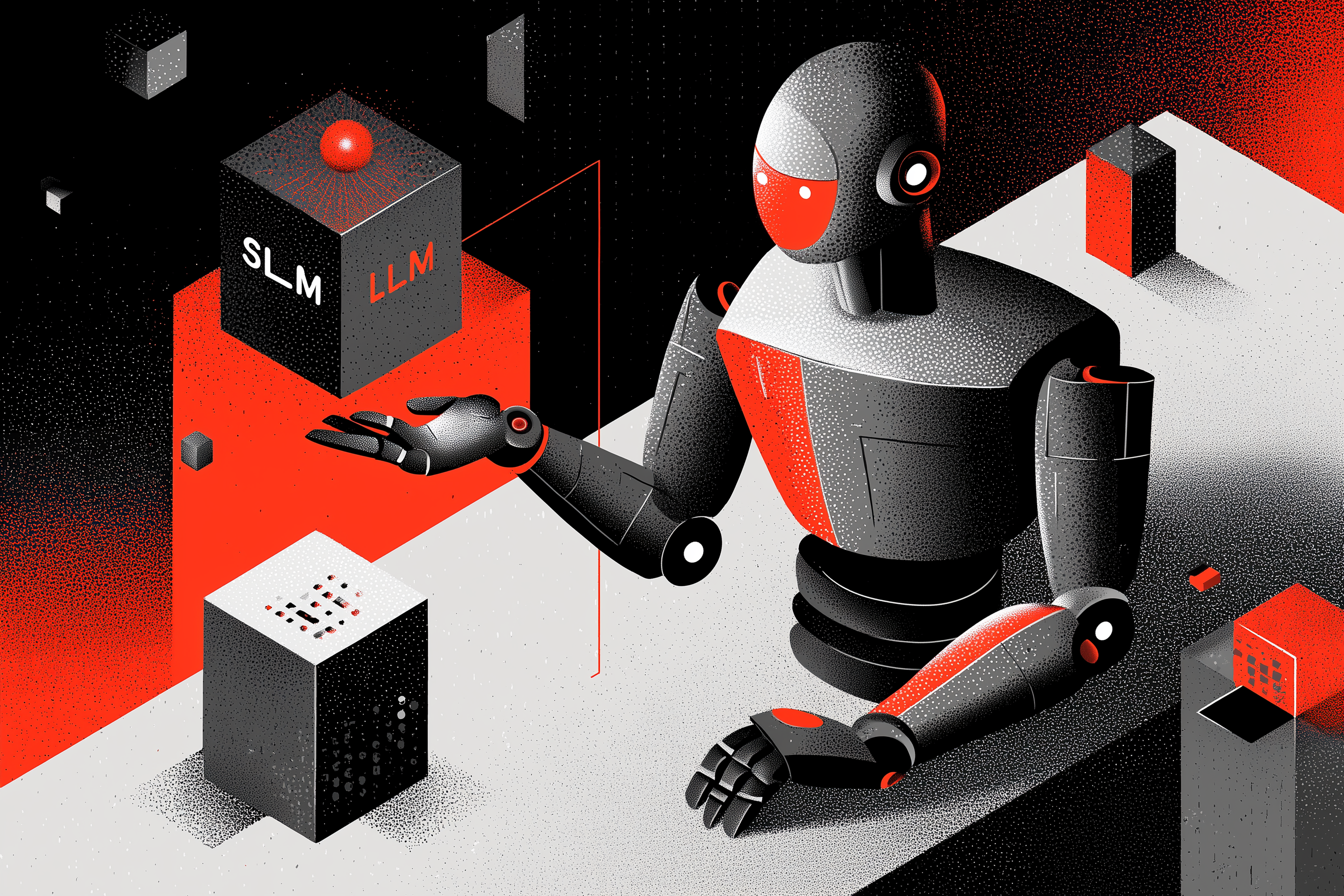Agentic AI and Small Language Models (SLMs): Accelerating Innovation and Accessibility

Discover how agentic AI and Small Language Models (SLM) are driving a shift toward more accessible, sustainable artificial intelligence.
The rise of more accessible AI in 2025
In 2025, artificial intelligence is reaching a new stage. While large language models (LLMs) like GPT-5 or Gemini still dominate the headlines, a strong trend is emerging: Small Language Models (SLMs) and Agentic AI.
According to McKinsey – The State of AI 2025, more than 60% of European companies report testing or deploying compact AI solutions in their business processes. This shift signals a major change: AI is no longer reserved for tech giants. It is becoming accessible, resource-efficient, and oriented toward human collaboration.
What is a Small Language Model (SLM)?
A Small Language Model (SLM) is an AI model designed to understand and generate natural language, but in a more compact, efficient form than an LLM.
- LLMs (Large Language Models): highly powerful but resource-hungry in terms of data, energy, and infrastructure.
- SLMs (Small Language Models): lighter, cheaper to train, and able to run locally or on smaller infrastructures (Microsoft Azure).
Example: a small business could integrate an SLM to power an internal HR chatbot or a document search assistant without relying on expensive cloud infrastructure.
In short, SLMs pave the way for democratized AI, suitable for both startups and large organizations (LeMagIT).
Agentic AI: toward autonomous yet collaborative systems
Agentic AI refers to systems capable of making decisions and executing actions autonomously, within a framework defined by humans.
Unlike a reactive chatbot, an agentic AI can:
- Identify a complex task.
- Plan the necessary steps.
- Act proactively, while reporting back to the user.
Concrete business examples
- Smart payments: real-time fraud detection and automation (ITSocial).
- Customer service: autonomous agents able to resolve simple cases without human intervention.
- Document management: automated sorting, archiving, and classification with integrated quality control.
As McKinsey (2025) notes: “Compact AI models will play a key role in democratizing artificial intelligence in business by reducing costs and improving energy efficiency.”
Opportunities with SLMs and Agentic AI
1. Accessibility and SME adoption
One of the biggest barriers to AI adoption has always been cost. With SLMs, small and medium-sized enterprises (SMEs) can now deploy an internal AI copilot without heavy infrastructure. This opens possibilities in retail, industry, healthcare, and education (Techniques de l’Ingénieur).
2. Data sovereignty and security
SLMs can run locally or via edge computing, limiting the transfer of sensitive data to external servers. For regulated industries like banking, healthcare, or government, this is a major advantage.
3. More sustainable, energy-efficient AI
LLMs require massive data centers. In contrast, SLMs consume up to 80% less energy (Techniques de l’Ingénieur, 2024). Less carbon footprint, more digital responsibility: a strong argument for businesses engaged in sustainability.
4. Human–AI collaboration: intelligent copilots
Instead of replacing humans, lightweight AI acts as a copilot. It supports decision-making, automates repetitive tasks, and leaves employees to focus on strategic, creative work.
Example: a project manager can rely on an agentic AI to generate reports, freeing up time for coordination and innovation (Harvard Business Review).
Toward responsible and inclusive AI
AI supporting digital inclusion
The accessibility of SLMs allows small organizations, even outside major tech hubs, to benefit from AI. This helps reduce digital inequality.
Lower environmental impact
With lighter energy requirements, SLMs contribute to a more sustainable AI ecosystem — a necessary shift as the digital sector already accounts for about 4% of global CO₂ emissions (The Shift Project).
Trust and transparency
Rather than opaque, massive models, SLMs and agentic AI foster trust and transparency between humans and machines — a crucial factor for broad adoption (Business Insider).
The future lies in human + AI co-creation
Agentic AI and Small Language Models (SLMs) mark a new stage in AI’s evolution. Cheaper, greener, and more accessible, they open up unprecedented opportunities for organizations of all sizes.
Rather than replacing humans, they act as strategic partners, driving innovation and enabling responsible AI. The future will be collaborative: a human + AI co-creation, where technology amplifies human potential instead of overshadowing it.
FAQ
1. What is a Small Language Model (SLM)?
An SLM is a more compact version of an AI language model, designed to be accessible, energy-efficient, and deployable by businesses of all sizes.
2. How is agentic AI changing business use cases?
It enables proactive automation of complex tasks (payments, customer support, document management) while staying human-supervised.
3. What benefits do SLMs bring to SMEs?
They lower the cost of entry, making AI available to smaller organizations without massive infrastructure.
4. Are SLMs more sustainable than large models?
Yes — they consume up to 80% less energy, reducing their carbon footprint.
5. How do agentic AI and SLMs foster innovation?
By handling repetitive tasks, they free teams to focus on creativity, strategy, and innovation.
Sources
- Algofi – Intelligence Artificielle : Entre Opportunités et Limites
- ITSOCIAL – L’essor des modèles de langage compacts (SLM) et de l’IA agentique dans la transformation des paiements
- LeMagIT – Small Language Models : les petits modèles d’IA montent en puissance
- Techniques de l’Ingénieur – L’usage des petits modèles de langage pourrait rendre l’IA plus accessible et responsable
- Microsoft Azure – What are Small Language Models ?
- McKinsey – The State of AI 2025 McKinsey & Company
- Harvard Business Review – How People Are Really Using Gen AI in 2025 Harvard Business Review
- Business Insider – What to Expect From AI in 2025 busine
Other Posts

Where should applied ai intervene to maximize the impact of marketing campaigns ?

How AI agentizes market data to write strategic pre-creation recommendations.

